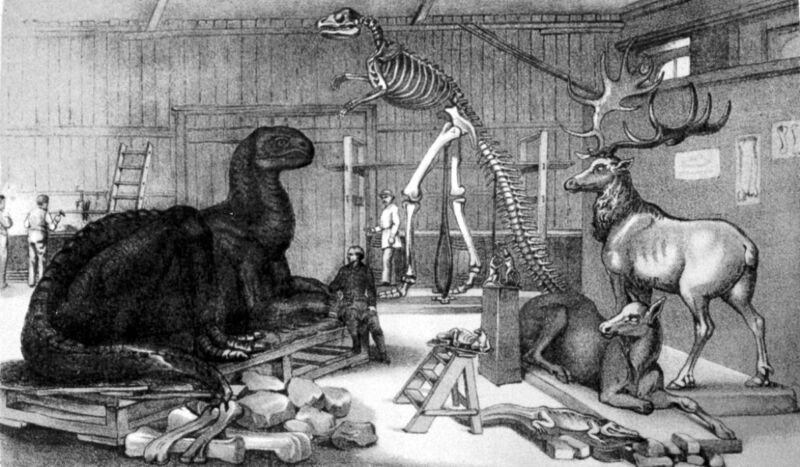
Public domain
The original plans for New York City’s Central Park included a Paleozoic Museum at 63rd Street and Central Park West, which would have housed life-sized concrete models of dinosaurs in carefully designed dioramas. Those plans were interrupted in 1871 when vandals broke into the workshop of the museum’s designer, Benjamin Waterhouse Hawkins, and smashed the models with sledgehammers, burying the rubble in the southwest corner of the park.
The traditional view in paleontological circles is that the man behind the destruction was William “Boss” Tweed, who pretty much ruled the city’s Democratic Party political machine with his cronies at Tammany Hall at the time. But a recent paper published in the Proceedings of the Geologists’ Association identifies another culprit: a lawyer and businessman named Henry Hilton, a member of the Tammany Hall contingent who championed plans for what would become the American Museum of Natural History.
Co-authors Victoria Coules and Michael Benton of the University of Bristol in England also found no evidence of a religious motivation for the destruction, i.e. opposition to the then nascent field of paleontology and its implications for evolutionary theory, which were deemed “blasphemous by some religious leaders. Rather, it appears to have been one of Hilton’s many “crazy moves”. “We discover that Hilton displayed an eccentric and destructive approach to cultural artifacts, and a remarkable ability to destroy anything he touched, including the vast fortune of department store magnate Alexander Stewart,” Coules and Benton wrote. “Hilton was not only bad, but also angry.”
Hawkins was an English sculptor and natural history artist who caused a sensation at the 1851 Great Exhibition in London with his life-sized dinosaur models. Cast in concrete and designed in collaboration with palaeontologist Sir Richard Owen, the models were then moved to what is now Crystal Palace Park. Owen even hosted a memorable dinner party on December 31, 1853, in the mold Hawkins had used to create the iguana sculptures.
Word of Crystal Palace’s dinosaurs spread to America and the board of commissioners responsible for developing plans for Central Park, led by Andrew Haswell Green. Hawkins was already in the US on a lecture tour and designed and cast an almost completed Hadrosaur skeleton for the Academy of Natural Sciences in Philadelphia – the world’s first mounted dinosaur skeleton. So he was a natural choice to create life-sized dinosaur sculptures for the planned Paleozoic Museum in Central Park. Green wrote to Hawkins in May 1868 offering him the commission, and Hawkins accepted. The board also commissioned architects Frederick Law Olmsted and Calvert Vaux to design the park’s layout and features.
The dinosaur models for the Paleozoic Museum would be based on those specimens found specifically in North America, although this was just before the famous American “bone rush” of the 1870s to 1890s yielded large numbers of fossilized dinosaur skeletons and bones. Hawkins was given a workspace in a large brick building known as the Armory (or Armory) on 64th Street, starting with small clay models based on the fossil evidence available before making the life-sized molds. Meanwhile, Olmsted and Vaux submitted their architectural plans for the museum building and excavated the foundations.
Unfortunately, by 1870, the political winds in New York City were shifting. Boss Tweed dissolved the board under Green’s leadership and appointed a new board with all its own people, headed by Peter Sweeny, with Hilton as treasurer. By then, there were plans to establish the more ambitious American Museum of Natural History (AMNH) on or next to Central Park. Hawkins had to move from the Armory to a nearby shed to continue his work to make way for the specimens and collections acquired for the AMNH.
The AMNH was not intended to rival the planned Paleozoic Museum; Green’s board had supported both projects. But Tweed’s newly appointed board thought otherwise and chose to abandon the project in May 1870. The official reason was economic. Their 1871 annual report specifically mentioned the high cost of completing the Paleozoic Museum (some $300,000, or about $7.5 million today), all coming from public funds, in contrast to the AMNH, which was supported by philanthropic fundraising. This was considered “too great a sum to spend on a building devoted wholly to paleontology – a science, interesting as it is, yet so imperfect as not to warrant such a large public outlay to illustrate it.” .” There were also plans for a zoo in Central Park, and the board favored supporting live animals over extinct ones.

